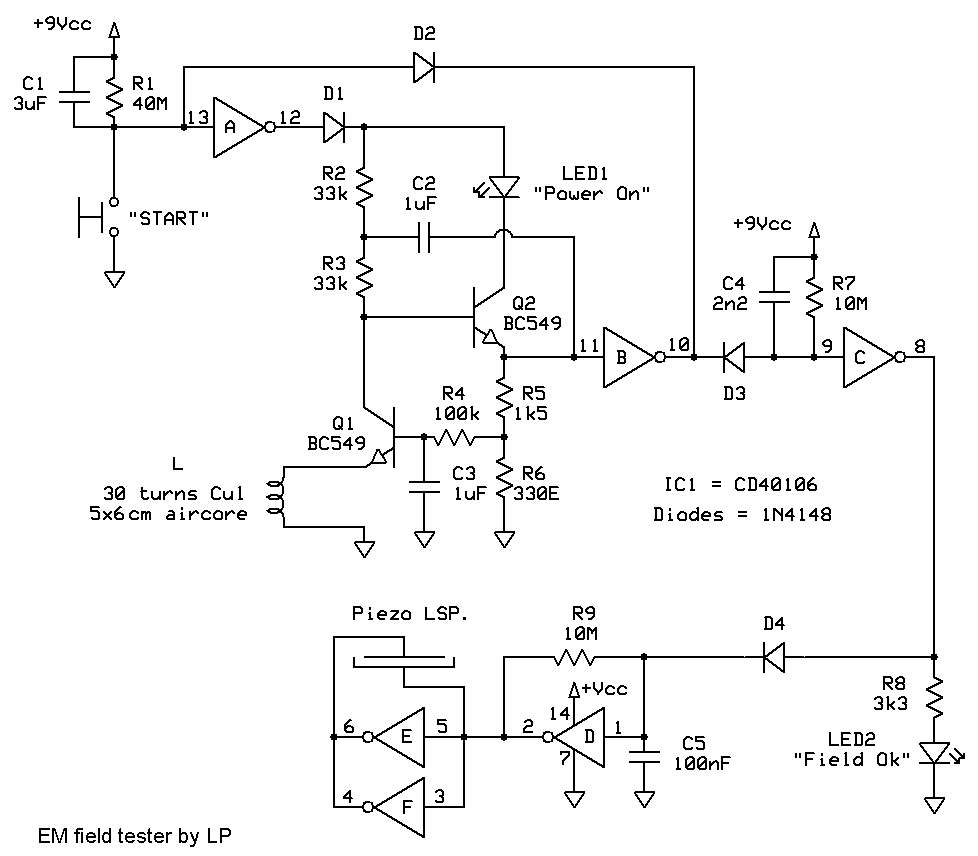This tester is a lightweight handheld device able to sense the strength of a low frequency pulsed electromagnetic field and indicate its presence in a simple and easy to understand manner, via an LED and a small piezoelectric loudspeaker. It is constructed using CMOS inverters found in an inexpensive CD40106 (hex Schmidt-input inverter) integrated circuit.

Inverter "A" formes a retriggerable monostable multivibrator with the holding period of around a minute. After a short press onto the "START" momentary push button, "A" inverter output goes logic "high" so that the preamplifier formed using bipolar transistors Q1 and Q2 gets its power supply voltage and starts to operate. Afer a minute, "A" inverter output goes back to logic "low" state turning off the tester. This is a fairly easy way to implement an auto power-off function.
Presence of pulsed EM field is sensed by the coil "L" containing approximately 30 turns of Cul wire wound on a 5 x 6 cm square plastic former with no ferrite core. Signals picked by the coil are amplified around a thousand times by a directly coupled AC signal preamplifier formed using Q1 and Q2. A simmilar preamplifier circuit is thoroughly described on
electronic stethoscope pages and that explanation is not going to be duplicated here. One peculiarity of this preamplifier is the "Power on" LED diode inserted into Q2 collector circuit. Its cathode could have been connected to GND instead to Q2 collector, but then the overall circuit power consumption would be doubled. This LED doesn't influence preamplifier AC performance.
It is important to note that the coil is connected to Q1 transistor low input impedance emitter circuit. This is done so in order to make the device sensitive only to varying electrical current flowing through the coil, not to voltage present at its contacts. If the coil was connected to a high input imledance preamplifier instead, then the tester would be sensitive to electrical component of the surrounding EM field, such as that formed in the proximity of power supply cords etc. That could easily cause misleading false positive readings when testing the strength of medicinal pulsating EM fields.
Positive semiperiods of the preamplifier output voltage are converted to sharp logic pulses by the inverter "B" operating as a signal limiter. These logic level pulses are then used to trigger the second monostable multivibrator formed around inverter "C". When inative, this inverter puts its output into "low" logic state, pulling via the diode D4 the input pin of the audio frequency oscillator formed around inverter "D" to ground, effectively stopping its operation. When active, inverter "C" puts its output into "high" logic state enabling the audio oscillator to produce clean squarewave signal at approximately 1kHz and 50% duty ratio at its output. This signal is then amplified (in terms of boosting the output current) by the isolating buffer formed out of inverters "E" and "F", and finally fed to the piezoelectric loudspeaker.
The second monostable multivibrator holding period is very short, around 30 ms. This is done so in order that low frequency pulsating EM fields can be tested in terms of approximate frequency by ear - if everything is Ok with the EM field, a sharp crispy periodic sound is heard coming from the loudspeaker. This enables experienced practitioners not merely to test the presence of a pulsating EM field but as well to test the ability of medicinal equipment to vary the frequency and/or the duty ratio of the generated EM field.
Diode D2 is used to retrigger the first monostable multivibrator each time a strong enough EM pulses are sensed by the preamplifier and signal limiter "B". This way a series of consecutive tests can be carried out by the staff with no need to restart the tester over and over. After all the job is done, the device silently goes to stand-by, reducing the battery drain to less than 1µA. This means that an alkaline 9V battery can easily provide for years of regular everyday use.

